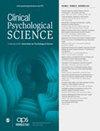焦虑症患者对威胁的感知阈值降低:来自知觉心理物理学的证据
IF 4.1
2区 医学
Q1 PSYCHIATRY
引用次数: 0
摘要
焦虑症的特征被认为是对威胁高度敏感。行为抑制系统(BIS)是焦虑症的一个危险因素,据推测它能反映这种威胁敏感性。在本研究中,我们填补了文献中的一个重要空白:无论是焦虑还是 BIS,都没有与威胁敏感性的行为测量指标(以降低与威胁相关的感知阈值为指标)明确联系起来。我们使用心理物理方法精确测量了检测威胁性面孔和中性面孔的绝对知觉阈值。我们研究了被诊断为焦虑症的人和未被诊断为焦虑症的人的自我报告的 BIS 和焦虑不安之间的关系。无论焦虑症诊断与否,较高的自我报告 BIS 和焦虑不安都与威胁性刺激和中性刺激的感知阈值降低有关,但在控制焦虑不安后,只有 BIS 显示出特定的关联。在本研究中,我们利用适应性心理测量法提供了关键的实证证据,证明特定的气质维度与跨焦虑症诊断的威胁敏感性知觉指数之间存在联系。本文章由计算机程序翻译,如有差异,请以英文原文为准。
Perceptual Thresholds for Threat Are Lowered in Anxiety: Evidence From Perceptual Psychophysics
Anxiety is believed to be characterized by heightened sensitivity to threat. The behavioral-inhibition system (BIS), a risk factor for anxiety, is hypothesized to index this threat sensitivity. In the present study, we address a critical gap in the literature: Neither anxiety nor BIS have been clearly linked with behavioral measures of threat sensitivity indexed by lowered threat-related perceptual thresholds. We used psychophysical methods to precisely measure absolute perceptual thresholds for detection of threatening and neutral faces. We examined their relationships with self-reported BIS and anxious apprehension in individuals diagnosed with anxiety disorders and individuals not diagnosed with anxiety disorders. Irrespective of anxiety disorder diagnosis, higher self-reported BIS and anxious apprehension were associated with reduced perceptual thresholds for threatening versus neutral stimuli, but only BIS showed a specific association after controlling for anxious apprehension. Using adaptive psychometrics, in this study, we offer key empirical evidence linking specific temperamental dimensions with perceptual indices of threat sensitivity transdiagnostically across anxiety disorders.
求助全文
通过发布文献求助,成功后即可免费获取论文全文。
去求助
来源期刊

Clinical Psychological Science
Psychology-Clinical Psychology
CiteScore
9.70
自引率
2.10%
发文量
35
期刊介绍:
The Association for Psychological Science’s journal, Clinical Psychological Science, emerges from this confluence to provide readers with the best, most innovative research in clinical psychological science, giving researchers of all stripes a home for their work and a place in which to communicate with a broad audience of both clinical and other scientists.
 求助内容:
求助内容: 应助结果提醒方式:
应助结果提醒方式:


